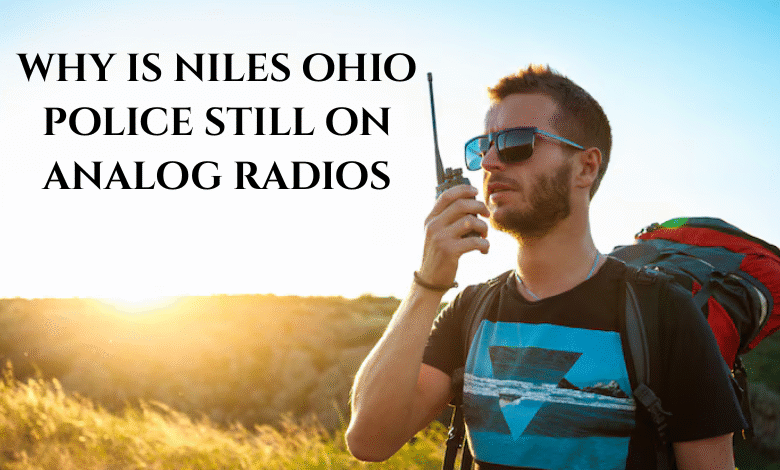Why is Niles Ohio Police Still on Analog Radios

Police departments rely on radio communication to keep officers connected, coordinate responses, and ensure public safety. For decades, analog radios were the backbone of these systems, delivering clear voice transmissions over long distances. Today, however, digital radios have taken center stage, offering features like encryption, GPS tracking, and improved sound quality. So why hasn’t the Niles Ohio Police Department jumped on the digital bandwagon?
The answer lies in a mix of practicality, budget realities, and the unique needs of this small Ohio community. Analog radios, while older, still get the job done for Niles and they do it without breaking the bank. In this article, we’ll unpack the reasons behind this choice, compare analog and digital technologies, and explore what it all means for the future of police communication in Niles and beyond.
A Brief History of Police Radio Communication
To understand why Niles Ohio Police still use analog radios, let’s take a quick trip through the history of police communication. It’s a story of innovation, adaptation, and sometimes sticking with what works.
The Early Years: One-Way Radios
-
1920s: Police communication started with one-way radios. Dispatchers could send messages to officers in the field, but officers couldn’t reply. They had to find a phone or call box to respond.
-
1930s: Two-way radios debuted, letting officers talk back to dispatch. These were analog systems, using VHF frequencies to carry voices across cities.
Analog Takes Over
-
1940s–1950s: Analog radios became the go-to choice for police departments. They were simple, reliable, and didn’t need fancy tech to work.
-
1960s–1980s: Improvements in analog technology like better antennas and frequency management made these systems even more effective. Departments like Niles Ohio built their communication networks around this tech.
The Digital Shift
-
1990s: Digital radios hit the scene, converting voice into binary code for clearer sound and added features. Encryption and data transmission became possible.
-
2000s–Today: The push for digital grew with standards like Project 25 (P25), which let different agencies talk to each other seamlessly. Big cities led the charge, but smaller towns often lagged behind.
Even with these advancements, Niles Ohio has held onto its analog roots. Why? Let’s dig into the tech itself.
Analog vs. Digital Radios: What’s the Difference?
Before we get into Niles’ specific situation, it’s worth understanding how analog and digital radios stack up. Each has its strengths and weaknesses, and those differences play a big role in why Niles hasn’t upgraded.
Analog Radios 101
Analog radios send voice signals as continuous waves think of them like an old-school AM/FM radio. They’ve been around forever and are known for being straightforward and dependable.
Digital Radios 101
Digital radios turn voice into 0s and 1s, like a computer file. This lets them pack in extras like encryption and text messaging, but it also makes them more complex.
Comparison Table: Analog vs. Digital Radios
|
Feature |
Analog Radios |
Digital Radios |
|---|---|---|
|
Sound Quality |
Can get staticky or muffled |
Crisp and clear, even in tough conditions |
|
Range |
Great for open spaces, less so in cities |
Shorter range but better in urban areas |
|
Cost |
Affordable to buy and maintain |
Pricey upfront and ongoing |
|
Features |
Just voice, no bells or whistles |
Encryption, GPS, texting, and more |
|
Ease of Use |
Super simple, no training needed |
More complex, requires some learning |
|
Interference |
Prone to static from weather or signals |
Less interference, more reliable audio |
The Bottom Line
-
Analog: Perfect for budget-conscious departments that need basic, reliable communication.
-
Digital: A must-have for agencies wanting top-tier security and modern features.
For Niles Ohio, the simplicity and cost savings of analog radios seem to outweigh the allure of digital upgrades.
Why Niles Ohio Police Stick with Analog Radios
So, why exactly has the Niles Ohio Police Department stayed with analog radios? It’s not just stubbornness—there are solid reasons behind this choice.
Money Matters
-
Upgrading Costs: Switching to digital means buying new radios, updating infrastructure, and training officers. For a small department like Niles, that’s a big financial hit.
-
Maintenance Savings: Analog systems are cheaper to keep running. No need for pricey tech support or fancy repairs.
Reliability Wins
-
Tried and True: Analog radios have been around forever and rarely let you down. They work in all kinds of weather and terrain.
-
No Learning Curve: Officers already know how to use them, so there’s no downtime for training.
Small Town, Simple Needs
-
Compact Area: Niles isn’t a sprawling metropolis. Its smaller size means long-range communication isn’t a huge concern.
-
Lower Stakes: With less crime than big cities, Niles doesn’t need encrypted radios to thwart high-tech criminals.
Looking Ahead
Niles hasn’t ruled out digital radios forever. If funding comes through or their needs change, they might make the leap. For now, though, analog does the trick.
The Upsides of Analog Radios for Police
Analog radios might seem old-fashioned, but they’ve got some serious advantages especially for a department like Niles Ohio.
They’re Budget-Friendly
-
Low Upfront Cost: You can outfit a whole team with analog radios without draining the bank.
-
Easy upkeep: Repairs are straightforward and don’t require specialized gear.
They’re Tough and Reliable
-
Long Reach: Analog signals travel far in open areas, perfect for a suburban or rural setup like Niles.
-
Built to Last: These radios can take a beating and still work, which is key for cops on the move.
They’re User-Friendly
-
No Fuss: Turn it on, talk, done. No complicated menus or settings.
-
Familiarity: Most officers grew up with analog, so it’s second nature.
For Niles, these perks make analog radios a smart, practical choice.
The Downsides of Sticking with Analog
Analog radios aren’t perfect, though. They come with some trade-offs that Niles and any department has to weigh.
No Fancy Features
-
No Encryption: Anyone with a scanner can listen in, which could be a risk.
-
Voice Only: You won’t get GPS or texting with analog.
Sound Struggles
-
Static City: Bad weather or other signals can mess with clarity.
-
Fading Signals: In dense areas, the audio might drop off.
Playing Nice with Others
-
Compatibility Woes: If nearby agencies go digital, Niles might struggle to coordinate with them.
The Long Game
-
Going Obsolete: As digital takes over, parts and support for analog could dry up.
Niles has clearly decided these downsides aren’t dealbreakers yet.
What’s Next for Police Radio Communication?
The future of police radios is leaning hard into digital, but not every department is ready to make the switch. Here’s a peek at where things are headed.
The Digital Wave
-
P25 Standards: These rules make digital radios work across agencies, a big deal for emergencies.
-
Security Boost: Encryption keeps sensitive chatter safe from prying ears.
Adoption Timeline
|
Era |
Tech |
What Changed |
|---|---|---|
|
1930s |
One-way analog |
Dispatch could reach officers |
|
1950s |
Two-way analog |
Officers could talk back |
|
1990s |
Early digital |
Better sound, new features |
|
2010s |
P25 digital |
Agencies linked up easily |
Niles’ Next Steps?
Niles might go digital if:
-
Cash Flows In: Grants or budget boosts could cover the cost.
-
Tech Gets Cheaper: Digital prices are dropping over time.
-
Needs Evolve: Growth or crime spikes might demand more features.
For now, analog holds steady in Niles.
Frequently Asked Questions
Got questions? We’ve got answers! Here’s what people often wonder about Niles Ohio Police and their analog radios.
Why do some police departments still use analog radios?
They’re cheap, reliable, and simple. For smaller departments like Niles, those qualities often outweigh the perks of digital.
What’s stopping Niles Ohio Police from going digital?
It’s mostly about money new gear and training cost a lot. Plus, their current system works fine for their needs.
Are analog radios safe for police use?
They’re not encrypted, so scanners can pick them up. But in low-crime areas like Niles, that’s less of a worry.
When might Niles Ohio Police switch to digital radios?
No set date, but it could happen if funding comes along or their community demands it.
How do analog radios hold up against digital ones?
Analog is cheaper and easier but lacks digital’s clarity and extras like GPS.
Wrapping It Up
The Niles Ohio Police Department’s choice to stick with analog radios isn’t about resisting change it’s about what works. Analog offers a budget-friendly, reliable way to keep officers connected in a small community. Sure, digital radios bring flashy features, but for Niles, the old-school approach still delivers.
As technology marches on, Niles might eventually go digital. Until then, their analog radios are a reminder that sometimes, simpler is better.



